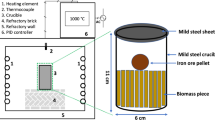Abstract
The resource utilization of copper slag is an attractive option of iron resource. Thermal energy recovery and direct reduction (TER-DR) system was proposed in this study. By theoretical analysis, the exergy efficiency of this system can reach to 57.3%. To investigate the feasibility of TER-DR system, copper slag composite pellets within lignite were prepared. As a new binder, pine sawdust was added into the pellets. The diameter of pellets was 20 mm in experiments and the compressive strength of them was up to 831 N when the addition ratio of biomass was 29%. The results showed that the overall iron recovery reached to 90% and the separated iron concentrate was up to 93.5% when the temperature is at 1423 K for 90 min with CaO addition ratio of 0.3. The process reduces the secondary environmental pollution of copper slag and will be applied well in the future.
Access this chapter
Tax calculation will be finalised at checkout
Purchases are for personal use only
Similar content being viewed by others
References
Fan Y, Shibata E, Iizuka A, Nakamura T (2014) Crystallization behaviors of copper smelter studied using Time-Temperature-Transformation Diagram. Mater Trans 55(6):958–963
Gorai B, Jana RK, Premchand (2003) Characteristics and utilisation of copper slag—a review. Resour Conserv Recycl 39(4):299–313
Palacios J, Sánchez M (2011) Wastes as resources: update on recovery of valuable metals from copper slags. Miner Process Extr Metall 120(4):218–223
Heo JH, Kim BS, Park JH (2013) Effect of CaO addition on iron recovery from copper smelting slags by solid carbon. Metall Mater Trans B 44(6):1352–1363
Zhang H, Shi X, Zhang B, Hong X (2013) Reduction of molten copper slags with mixed CO-CH4-Ar gas. Metall Mater Trans B 45(2):582–589
Zhang LZ, Zhang L, Wang MY (2005) Oxidization mechanism in CaO-FeOx–SiO2 slag with high iron content. Trans Nonferr Met Soc China 15(4):938–943
Gyurov S, Rabadjieva D, Kovacheva D, Kostova Y (2014) Kinetics of copper slag oxidation under nonisothermal conditions. J Therm Anal Calorim 116(2):945–953
Bruckard WJ, Somerville M, Hao F (2004) The recovery of copper, by flotation, from calcium-ferrite-based slags made in continuous pilot plant smelting trials. Miner Eng 17(4):495–504
Warczok A, Riveros G (2007) Slag cleaning in crossed electric and magnetic fields. Miner Eng 20(1):34–43
Wang CL, Yang HF, Jiang BP, Zhang JL, Lu LF, Tang QY (2014) Recovery of iron from lead slag with coal-based direct reduction followed by magnetic separation. Adv Mater Res 878:254–263
Yang HF, Dang CG, Xu W (2011) Preparation of geopolymer using the slag from direct reduction-magnetic separation of refractory iron ore (SDRMS). Adv Mater Res 383–390:911–915
Barati M, Esfahani S, Utigard TA (2011) Energy recovery from high temperature slags. Energy 36(9):5440–5449
Liu J, Yu Q, Zuo Z, Duan W, Han Z, Qin Q, Yang F (2016) Experimental investigation on molten slag granulation for waste heat recovery from various metallurgical slags. Appl Therm Eng 103:1112–1118
Ishida M (1995) Thermodynamics-its perfect comprehension and applications-(in Japanese). Baifukan (93)
Akiyama T, Oikawa K, Shimada T, Kasai E, Yagi J (2000) Thermodynamic analysis of thermochemical recovery of high temperature wastes. ISIJ Int 40(3):286–291
Duan W, Yu Q, Qin Q, Hou L (2014) Thermodynamic analysis of bf slag waste heat recovery system using enthalpy-exergy diagram. J Northeast Univ (Nat Sci) 35(11):1566–1570
Akiyama T, Yag J (1998) Methodology to evaluate reduction limit of carbon dioxide emission and minimum exergy consumption for ironmaking. ISIJ Int 38(8):896–903
Liu J, Yu Q, Peng J, Hu X, Duan W (2015) Thermal energy recovery from high-temperature blast furnace slag particles. Int Commun Heat Mass Transfer 69:23–28
Author information
Authors and Affiliations
Corresponding author
Editor information
Editors and Affiliations
Rights and permissions
Copyright information
© 2018 The Minerals, Metals & Materials Society
About this paper
Cite this paper
Zuo, Z., Yu, Q., Xie, H., Qin, Q., Wei, M. (2018). Direct Reduction of Copper Slag Composite Pellets Within Lignite Using Biomass as Binder. In: Sun, Z., et al. Energy Technology 2018 . TMS 2018. The Minerals, Metals & Materials Series. Springer, Cham. https://doi.org/10.1007/978-3-319-72362-4_6
Download citation
DOI: https://doi.org/10.1007/978-3-319-72362-4_6
Published:
Publisher Name: Springer, Cham
Print ISBN: 978-3-319-72361-7
Online ISBN: 978-3-319-72362-4
eBook Packages: Chemistry and Materials ScienceChemistry and Material Science (R0)




